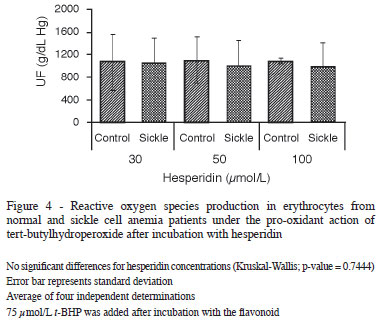OBJECTIVE: The aim of this study was to evaluate the protective effects of quercetin, rutin, hesperidin and myricetin against reactive oxygen species production with the oxidizing action of tert-butylhydroperoxide in erythrocytes from normal subjects and sickle cell anemia carriers treated with hydroxyurea. METHODS: Detection of intracellular reactive oxygen species was carried out using a liposoluble probe, 2',7'-dichlorfluorescein-diacetate (DCFH-DA). A 10% erythrocyte suspension was incubated with flavonoids (quercetin, rutin, hesperidin or myricetin; 30, 50, and 100 µmol/L), and then incubated withtert-butylhydroperoxide (75 µmol/L). Untreated samples were used as controls. RESULTS: Red blood cell exposure to tert-butylhydroperoxide resulted in significant increases in the generation of intracellular reactive oxygen species compared to basal levels. Reactive oxygen species production was significantly inhibited when red blood cells were pre-incubated with flavonoids, both in normal individuals and in patients with sickle cell anemia. Quercetin and rutin had the highest antioxidant activity, followed by myricetin and hesperidin. CONCLUSION: Flavonoids, in particular quercetin and rutin, showed better antioxidant effects against damage caused by excess reactive oxygen species characteristic of sickle cell anemia. Results obtained with patients under treatment with hydroxyurea suggest an additional protective effect when associated with the use of flavonoids.
Flavonoids; Quercetin; Rutin; Hydroxyurea; Anemia, sickle cell; Reactive oxygen species





